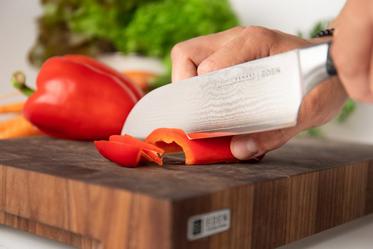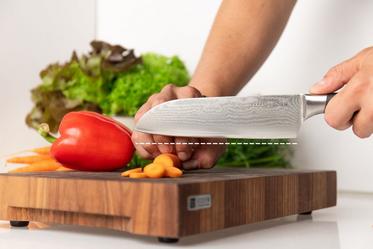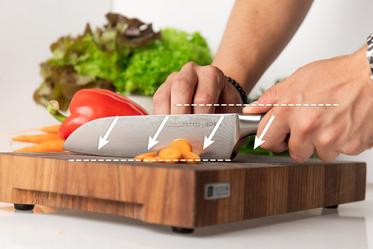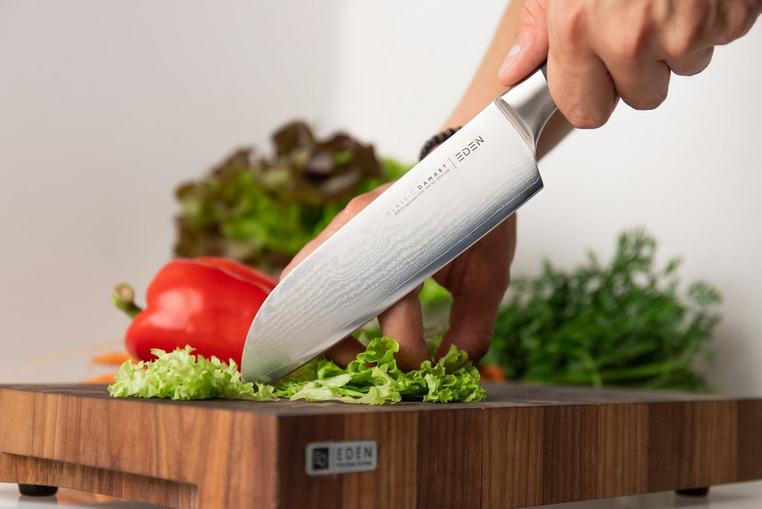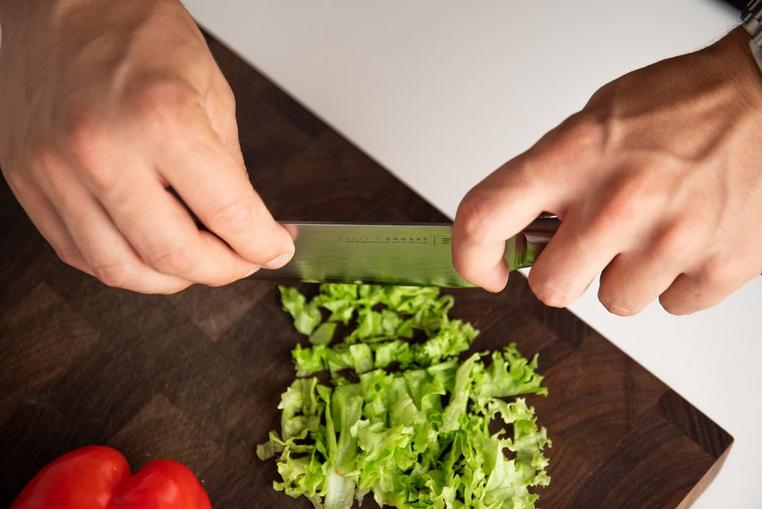How to: Cutting with a santoku kitchen knife
The santoku is the Japanese version of the European chef's knife. Where a European chef's knife is recognizable by its pointed tip and convex edge, a santoku has a slightly “blunter” blade shape and a straight edge. This means you cut differently with a santoku than with a European chef's knife. But how does that work exactly? And what cutting techniques does a santoku knife excel at?
The benefits of a straight edge
Due to the straight edge, the santoku doesn't rock on the cutting surface, as is the case with the more “rounded” edge of a chef's knife. The benefit of this is that the entire length of the cutting edge comes into contact with the cutting board that you're cutting on. You don't have to rock the blade while cutting to use the entire length of the edge. The placement of the handle also helps with this. It is higher than the edge, so your knuckles don't touch the cutting board.
Read more about the difference between a chef's knife and a santoku.
What can you cut with a santoku knife?
A santoku is super versatile. A real all-rounder! You can use it to cut vegetables, meat and fish. Although we think a santoku knife particularly excels at cutting vegetables. Partly because of the blade shape, but also because a santoku is generally sharper and thinner than a European chef's knife. This makes it really easy to cut vegetables into small cubes for sauces and poke bowls!
Cutting with a santoku
The straight edge, and its benefits, influence how you cut with a santoku knife. It's worth noting that you will rarely only use the tip. Optimal use of the straight edge is the key.
Correct positioning of your hands and fingers
The pinch grip is popular among professional chefs and amateur chefs. This is a technique where you clamp the beginning of the blade between your thumb and index finger. You fold the other three fingers loosely around the handle. Because you grip the blade close to the handle, you have lots of control over what you're cutting. This means you not only work more precisely, but you also prevent outliers and reduce the risk of hitting yourself.
Does this mean that grasping the handle with your whole hand is wrong? Absolutely not! This puts more power behind your cutting movement. This is beneficial when you're cutting large vegetables such as cabbage. But that much power is almost never needed for a santoku. Let the sharp, thin edge do its work and trust the cutting technique you're using.
Tip: use the height of the blade. Hold what you want to cut with your fingertips and slightly curl your fingers, like a claw. Your knuckles now stick out slightly and act as a guide for the blade.
The push technique
Now that you've mastered the proper positioning of your hands and fingers, it's time to cut with the santoku. The push technique is the best method for this. In the starting position, always keep the knife horizontal above the cutting board. The distance between the tip of the blade and the cutting board is always the same as the distance between the heel of the blade and the cutting board. Gently push the blade diagonally towards what you want to cut. In our case: a bell pepper. Cut the bell pepper and return the blade to the horizontal starting position.
Repeat this movement several times and give yourself time to master it. Always keep the spine of the blade against your knuckles when cutting. And slowly work your fingers backwards with each cutting motion until the bell pepper is completely sliced. Over time and after cooking several dishes, you'll notice that this happens more and more smoothly. Practise, practise, practise! This technique works with almost any vegetable. Even a thick carrot doesn't stand a chance.
This technique is also suitable for precise cutting tasks. When you cut a clove of garlic, for example. Use the same pushing technique, but only use the first few inches of the edge.
Rocking
Rocking is a cutting technique where you place the tip of the blade on the cutting board, and you bring the heel of the blade to what you want to cut. The tip always remains (approximately) in place and doesn't come away from the cutting board. The movement you make is very similar to how a boom barrier works. This cutting technique is popular for finely cutting herbs.
Ideally, the knife has a curved edge. This technique therefore works very well with a European chef's knife, which generally has a more convex edge. However, no two santokus are the same and not every santoku has a dead straight edge. So how efficiently this works really depends on the design of the blade.
Chopping
A santoku knife is not a cleaver. Even though these two knives are sometimes quite similar in design. If you use a santoku like a cleaver, you risk blunting the edge. Or worse: breaking it! Also, a santoku is usually lightweight, and doesn't have the weight of a cleaver which is needed to properly chop. It's only possible to “chop” herbs and soft vegetables with a santoku. Grab the tip of the blade with a (here it is again) pinch grip and grab the handle with your other hand. Then gently chop the herbs. The santoku's straight edge comes into its own again here! Don't use too much force, otherwise you run the risk of the edge twisting (bending or folding). Especially with Japanese knives that have a sharp, thin grind.
Be creative!
The santoku is a surprisingly versatile kitchen knife. Although it might not seem that way, as it excels in the push technique. Still, it all just depends on how skilled you are with the knife. There are plenty of videos on the internet showing a chef filleting a fish with a santoku. Nevertheless, we recommend a filleting knife for this. But it does show how versatile a santoku is!
Curious about our entire selection of santoku knives? Look here!


?%24center=center&%24poi=poi&%24product-image%24=&fmt=auto&poi=%7B%24this.metadata.pointOfInterest.x%7D%2C%7B%24this.metadata.pointOfInterest.y%7D%2C%7B%24this.metadata.pointOfInterest.w%7D%2C%7B%24this.metadata.pointOfInterest.h%7D&scaleFit=%7B%28%24this.metadata.pointOfInterest%29%3F%24poi%3A%24center%7D&sm=c&w=373)
